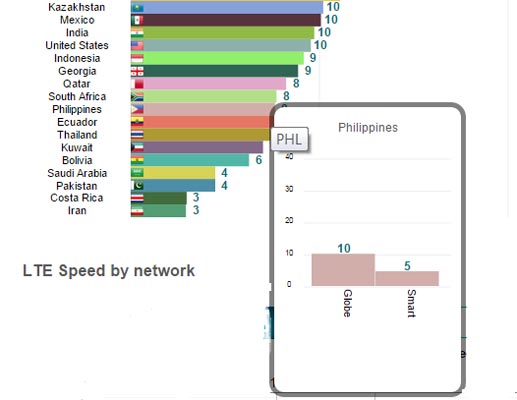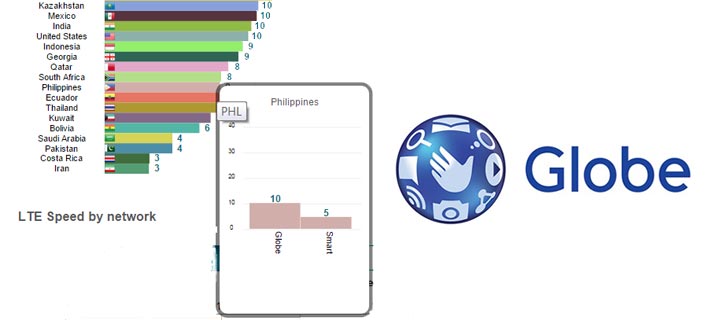Providing fastest mobile internet service in the Philippines
Globe Telecom provides the fastest LTE service in the Philippines, affirming the superiority of its mobile internet service and network infrastructure amid intensely competitive environment in the local telecommunications industry.
Based on OpenSignal’s State of LTE report for the third quarter of 2015, Globe Telecom’s LTE download speed is at 10 Mbps, double its competition’s LTE download speed of only 5 Mbps. Globe Telecom’s LTE download speed is comparable to territories/countries like Hong Kong (Smart Tone), India (Airtel), Norway (Telenor, Network Norway), Portugal (NOS), Indonesia (Indosat), which all registered a 10 Mbps download speed, and even higher than the 8 Mbps download speed in Russia (MTS), Malaysia (DiGi) and even US (AT&T, US Cellular, Sprint, C Spire Wireless).
While Globe Telecom’s download speed of 10 Mbps is considered adequate, its competition’s download speed of 5 Mbps dragged down the Philippines’ average LTE download speed to 8Mbps. OpenSignal specializes in mobile coverage mapping by crowdsourcing signal strength, data speed and reliability. In terms of LTE coverage, that of Globe is also superior at 41% against its competitor’s 36%.

“These findings prove our success in continuously expanding our network capacities amid ever-increasing demand for high-speed mobile internet access as more and more of our customers build their life and work experiences around a digital lifestyle,” said Yoly Crisanto, Globe Senior Vice President for Corporate Communications, noting that about a third of the company’s 48.4 million mobile customers are now using smartphones.
As part of the company’s aggressive LTE rollout, the Globe network’s mobile ultra-broadband access in Visayas and Mindanao were expanded, utilizing the LTE-TDD and LTE-FDD technologies, Agustin said. Currently one of the most relevant mobile network technologies, 4G LTE offers much higher bandwidth, lower latency even as it increases overall network capacity. This allows customers to use more applications on their mobile devices.
Crisanto said the continuing expansion of Globe network capacities is intended to provide its customers with holistic digital experience as the company continues to offer products and services that enhance the Filipino digital lifestyle. “Globe is committed in providing the right infrastructure support to ensure that the data needs of our customers are served, thus strengthening our position as the network of choice for smartphone users in the country. When it comes to mobile internet speed, we believe that the Philippines can compete globally but there is a need to distinguish between mobile and wireline,” she added.
Amid ongoing network expansion, Globe capital expenditure this year is expected to reach $850 million. As of June this year, capex stood at P11.4 billion, bulk of which were allocated for data-related projects that include investments for the company’s broadband network, capacities for wireless data, LTE, domestic and international transmission facilities. A significant portion of the company’s capex for the year were also allotted for its IT infrastructure as Globe continues to create platform for new products as well as to build on its IT transmission initiatives.
The OpenSignal data is collected from real consumer smartphones and is recorded under conditions of normal usage. Rather than approximate the user experience, it is directly measured from the users of OpenSignal smartphone application, which can be freely downloaded on both iOS and Android devices, and thus it is able to constantly monitor the true network experience that users are getting on those devices.
Through the app, OpenSignal is able to observe the network exactly as the end user experiences it. Such customer-centric approach allows OpenSignal to measure the true end-to-end experience of the mobile network. It isolated the networks in the Philippines by extracting all those points sent with network IDs corresponding to the brands operational there and then perform a geographical query to isolate only those data points that have been captured within the region. The different brands have been identified by investigating the network names associated with the SIM in the reporting device and the network which is serving the device.
Liked this post? Follow SwirlingOverCoffee on Facebook.


